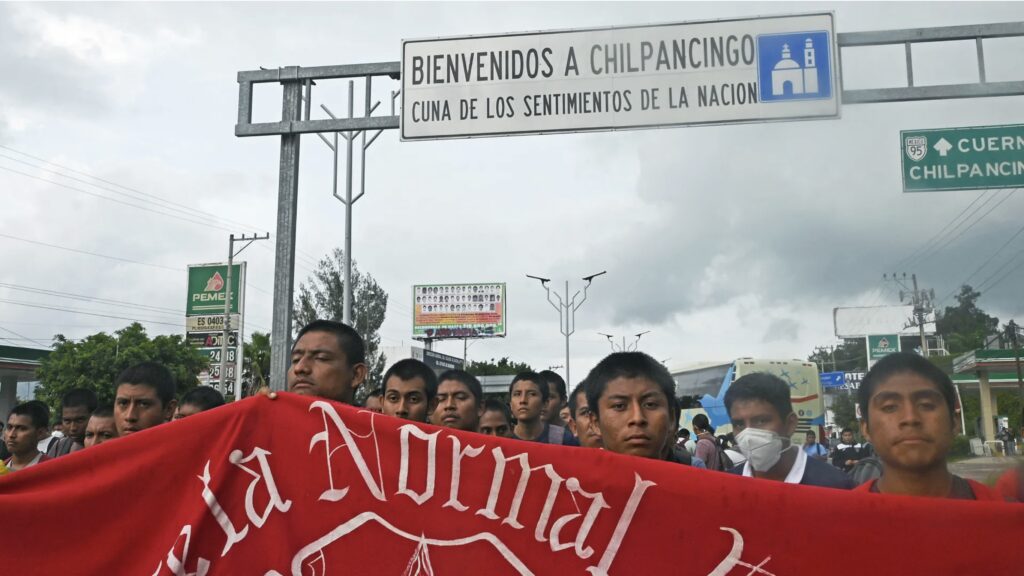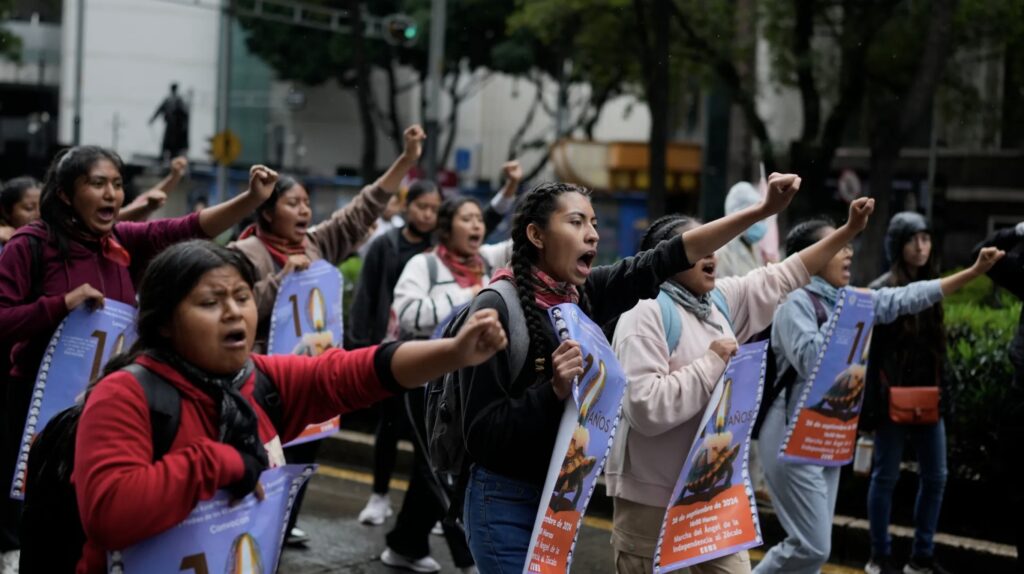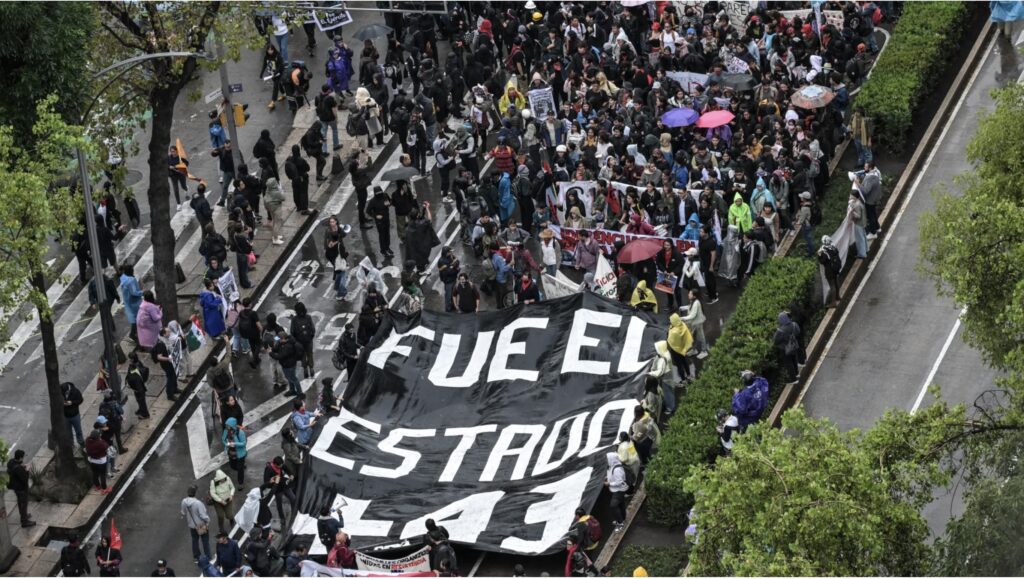Tuxtla Gutierrez, Mexico – Jesus Alain Vasquez Perez’s final moments were captured by a grainy surveillance camera hoisted high above the Chicoasen highway.
The footage is only seconds long. Suddenly, three vehicles zoom into view: one pick-up truck pursued by two police cruisers, their sirens flashing red against the ink-black night.
One of the police vehicles overtakes the pick-up. It cuts in front, manoeuvring as if to slow the pick-up down. But in that moment, a figure falls from the bed of the truck.
It rolls onto the road. It stops moving. The second police cruiser swerves to avoid it.
Protests had gripped the city of Tuxtla Gutierrez, in the southern Mexican state of Chiapas, on the night of May 15. Students from the Mactumatza teacher training school had been rallying for better access to education and resources.
One of those students — 20-year-old Maria, who asked to be identified by a pseudonym — had taken a break from demonstrations that night. She was spending time at the school when she learned one of her fellow protesters had gotten hurt.
She left to see for herself. She found Vasquez limp on the highway.
“I went up [to the highway] to see him, and he was on the ground. He was bleeding,” Maria said. “I was in shock. This was completely unexpected. He was just at a protest.”
How Vasquez came to fall from the pick-up truck that night would become the subject of fierce debate in the days to come. That debate, experts say, underscores the distrust that has festered between Mexico’s state police and some of its poorest students.

A tradition of protest
Mactumatza, the school Vasquez attended, is located on the outskirts of the city, not far from the highway where he died.
It is part of a nationwide network of government-funded normal schools, also known as teacher training colleges, where low-income students can enjoy free tuition and board.
Mexico’s history of normal schools stretches all the way back to the 1910s and 1920s, when the country was emerging from its revolutionary period. Many of the schools’ curriculums emphasise social justice, and students are encouraged to take jobs in underserved communities.
But that revolutionary spirit has also made the normal schools hotbeds for activism. “Normalistas”, as the students are called, have a long tradition of protest.
Sometimes they block highways. Other times, they occupy toll booths. One of their most famous activities is the nonviolent commandeering of local buses: The practice is so common that many bus drivers know to simply step aside when their vehicle is boarded.
Professor Tanalis Padilla, a historian at the Massachusetts Institute of Technology, said the public reaction to such protests has been mixed. Some people support the students wholeheartedly. Others, she said, express annoyance at “the radical kids out there again on the streets”.
According to Padilla, negative news coverage has contributed to that scepticism. “It’s safe to say the media has always been against them, calling them vandals and things like that.”
Padilla explained that this perception stems from the educational programme at the normal schools, which is rooted in socialist and collectivist politics.
“With the Cold War in the ’70s and ’80s, the media would portray the schools as hotbeds of radicalism and social disturbance,” she said.
Over the years, numerous normalista protests have culminated in violent clashes with police — and even death.
The most infamous incident took place in September 2014, when 43 students from the Ayotzinapa Rural Teachers’ College, another normal school, took over a bus in the state of Guerrero. They planned to use it to join a protest in Mexico City.
What happened next remains unclear. But it is believed that the students were kidnapped and killed with the knowledge of local law enforcement.
Not a single one of the students was ever seen alive again. Charred remains belonging to three of the Ayotzinapa students were later identified using DNA testing.
The Ayotzinapa case garnered widespread outrage and support for normalistas in Mexico and abroad.
“What happened was so shocking and so vicious that there was a general reaction of sympathy” towards normalistas, Padilla explained.

Parallels across time
In Tuxtla Gutierrez, student leaders say Vasquez’s death touched a nerve because it came mere days before the anniversary of another violent confrontation between police and the normalistas.
On May 18, 2021, normalistas from the Mactumatza school had been protesting a requirement that would have forced them to take their exams remotely.
The students argued that online test-taking would prevent those without computers or reliable internet from succeeding. They pointed out that, of all Mexico’s 31 states, Chiapas is the poorest. More than 76 percent of its population is below the poverty line — nearly 35 points above the national average.
But the protest prompted a police crackdown, and 93 students were arrested. Amnesty International, a human rights group, criticised the arrests for “using illegal and excessive force” and noted that some of the female protesters reported being sexually assaulted.
Father Filiberto Velazquez Florencio, a lawyer and human rights advocate, said that what unites all these cases is the lack of accountability for police actions, with “the police using excessive force, and the government giving a version that revictimises the students”.
Through his work as director of the Minerva Bello Centre, a civil society organisation, Father Velazquez advocates for student protesters who have faced police violence.
He has been working closely with the Mactumatza normalistas to reconstruct what happened on the night Vasquez died, using video footage and student testimony.

Conflicting narratives
The state police force involved in Vasquez’s death, the Fuerzas de Reaccion Inmediata Pakal (FRIP), commonly known as the “Pakales”, has denied responsibility for his fall.
Al Jazeera was unable to reach the FRIP for comment, but in a statement given to the local newspaper El Heraldo, a police spokesperson indicated that the protesters’ reckless driving was to blame for the death.
While an investigation into the incident remains ongoing, media reports have carried allegations that some of the students attempted to kidnap a police officer in the lead-up to the car chase.
But the testimonies Father Velazquez has gathered suggest a different story. The students told him that they had tried to commandeer a tourist bus “when about 20 Pakales patrol cars arrived”.
“They pointed guns at them, made threats,” Father Velazquez said. “They prevented the students from taking the bus, and as they wanted to arrest some of the students, the students fled and split up.”
Maria, the student protester, also accused the police of attempting to intimidate the students.
“They arrived with guns. The students were scared and trying to get away as fast as possible,” said Maria.
As police chased after the pick-up carrying Vasquez, Father Velazquez said there is evidence officers were “firing shots” and ramming the truck. He believes those factors contributed to Vasquez’s death.
“One of the classmates who was next to Alain in the truck was hit by something,” Father Velazquez said. “I don’t know if it was a rubber bullet, but it went through his shirt and hit him in the chest, and he fell backwards.”
Vasquez ultimately died in a nearby hospital. Chiapas state Attorney General Jorge Luis Llaven Abarca has told the media that the cause of death was head trauma.
His office has ruled out gunfire as the cause of death, but it is investigating whether officers used their firearms during the high-speed chase.

A dedicated teacher
But for many of the students at the Mactumatza normal school, Vasquez’s death is yet another instance of the police’s use of excessive force.
Maria believes that the investigation has so far been incomplete. She told Al Jazeera that no law enforcement official ever interviewed her to hear her side of the story.
“They haven’t heard our testimony. They haven’t considered the evidence that we have, from being at the scene and seeing his body,” said Maria.
A spokesperson for the Chiapas attorney general’s office said that the ongoing investigation will include the testimony of students who were present when Vasquez fell.
Meanwhile, Vasquez’s classmates have been holding protests, both in Tuxtla Gutierrez and in Mexico City, to push for greater accountability.
They remember Vasquez as a talented basketball player and a dedicated teacher who stayed up all night to prepare lessons for his students. He had entered his fourth and final year of college when he died.
Paula, another student protester who asked to remain anonymous, recalled that Vasquez’s students “cried for their teacher when they heard the news” of his death.
“There is nothing anybody can do to bring our friend back,” she said. “But meanwhile, we demand justice for his death.”
Source: AlJazeera by Ann Deslandes
Feature photo source: BBC


